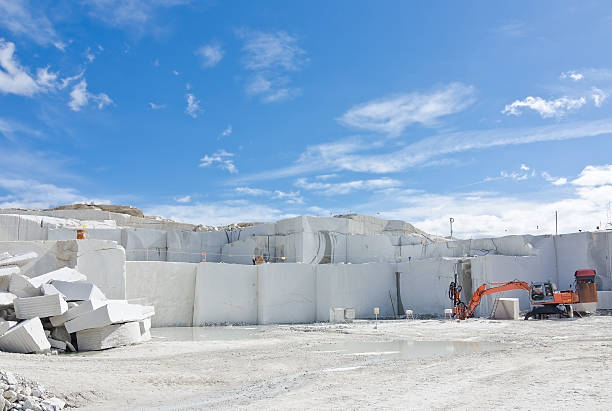Diving into of Granite Quarries in South Africa
Unearthing the Rich History and Sustainable Practices of Granite Quarrying
As we base on the precipice of revealing the intricate tapestry of granite quarrying, a trip via time exposes not just the physical act of extracting rock however likewise the cultural and historical relevance woven right into the extremely fabric of this practice. From the ancient origins that laid the foundation for contemporary quarrying methods to the sustainable techniques that are shaping the future of this sector, each carve mark on granite surfaces narrates waiting to be unearthed (granite quarries in south africa). The tradition of granite quarrying extends much beyond mere extraction; it is a testimony to human resourcefulness, strength, and the long-lasting appeal of this marvelous rock
Ancient Origins of Granite Quarrying
Dating back to old civilizations, the method of quarrying granite has actually been an indispensable part of human background and architectural improvement. The earliest proof of granite quarrying go back to old Egypt, where enormous pyramids and elaborate sculptures were crafted from this sturdy stone. The Egyptians used primitive devices to draw out granite blocks from quarries, showcasing the significance of this product in their significant constructions.
Moving on in history, the Greeks also made considerable contributions to the quarrying of granite. The Greeks used granite in different building marvels, such as temples and statues, showing their ability in shaping and sculpting this sturdy rock. The Romans even more fine-tuned the methods of quarrying granite, using innovative tools like knives and hammers to essence and form granite for their legendary frameworks.
Via the centuries, the method of quarrying granite has actually advanced, with modern-day innovations improving performance while keeping the classic appeal of this all-natural stone - granite quarries in south africa. From old human beings to contemporary builders, the legacy of granite quarrying continues to form our globe
Advancement of Quarrying Methods
The advancement of quarrying methods has been marked by a continual progression towards higher performance and accuracy in drawing out granite. From the fundamental techniques employed by our forefathers to the sophisticated modern technologies utilized in contemporary quarrying operations, the market has actually gone through significant advancements. Early quarrying strategies involved hands-on labor with standard tools such as chisels, hammers, and wedges to remove granite blocks from the planet. As civilizations progressed, techniques like fire-setting and primitive explosives were presented to assist in the extraction procedure.
Developments in computer-controlled tools and 3D modeling have enhanced quarrying procedures, leading to very little ecological impact and boosted sustainability methods. As the demand for granite proceeds to climb, the development of quarrying methods remains important to conference market requires efficiently and sustainably.
Cultural Relevance of Granite
Granite holds an extensive social importance across numerous civilizations because of its long-lasting presence in architectural masterpieces and revered monuments. From the impressive pyramids of Egypt to the elaborate carvings of the Angkor Wat holy place in Cambodia, granite has actually been a material of option for expressing grandeur and durability in cultural heritage. In ancient Rome, granite columns decorated holy places and public buildings, signifying strength and durability. The social value of granite expands past its physical characteristics; it embodies durability, stability, and eternity, making it a symbol of sustaining traditions and practices.

Sustainable Practices in Quarrying
Among the rich background of granite quarrying and its cultural value lies an expanding focus on sustainable practices within the sector. As environmental understanding and concerns concerning resource deficiency have increased internationally, the quarrying field has actually increasingly accepted sustainable techniques to decrease its impact on the atmosphere and bordering communities.

Additionally, recovery and rehabilitation of quarry sites post-extraction are indispensable to sustainable practices. By recovering quarried locations to a natural or helpful state, such as producing wildlife habitats or entertainment rooms, quarriers can offset he said the ecological impact of their operations and add positively to the local community.
Legacy of Granite Quarrying
With a historical backdrop soaked in workmanship and industrial progression, what sustaining impact has granite quarrying left on the landscape of modern-day culture? The tradition of granite quarrying transcends simple extraction methods; it has formed building marvels, city landscapes, and social heritage worldwide. The resilient nature of granite has made it a preferred selection for monoliths, buildings, and infrastructure, standing as a testimony to the ability and virtuosity of quarry workers across generations.
In addition, the financial impact of granite quarrying can not be forgotten. The market continues to give job opportunity and drive regional economies in regions where granite removal prevails. It has additionally stimulated technical advancements in quarrying techniques and devices, bring about extra efficient and sustainable practices.
In regards to sustainability, the legacy of granite quarrying includes efforts to reduce environmental impacts with reclamation tasks and responsible resource monitoring. By stabilizing economic rate of interests with environmental stewardship, the market makes every effort to make sure that future generations can proceed to gain from this enduring all-natural source.
Conclusion
